Culling and Fry Selection to Maintain A Linebred Strain Veiltail and Broadtail Moor Goldfish (1/3)
by David Linnemeyer& David Schleser
(no part may be published without permission of authors)
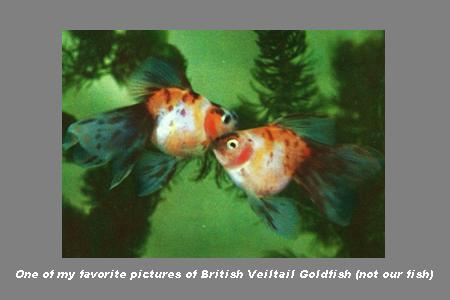
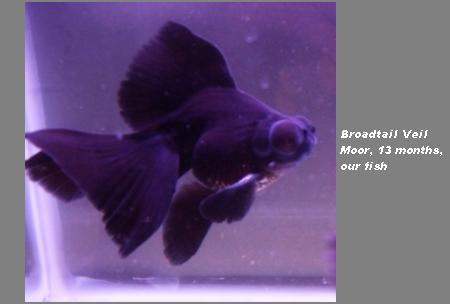
Objective: Stringent culling of a veiltail spawn with a Standard as a guide resulting in quality offspring for future breeding.
Disclaimer! What follows are my experiences, New Orleans, and those of my goldfish breeder partner Dave Schleser of Dallas over the past 35 years working with our strains of veils and broadtails. What has worked for us may not necessarily lead to the same results for others working with different strains under different environmental conditions.
Definitions, Nomenclature in veils can be a mess, different names for the same fish depending on who is speaking. Tradition also comes into play. For this article we will use the following:
- Veiltail: Elongated fins, caudal fin up to one and a half times body length when mature. Many, including ourselves, prefer a somewhat shorter caudal.
- Broadtail Veil: Technically the term broadtail should only refer to a square-edged tail, has nothing to do with length. There can be short-tailed broadtails, (choptails) and butterfly-tailed broadtails. The English veiltail version which we raise should really be called broadtail veil moor.
- Fringetail: A fringetail veil has the elongated fins of a veil but with a forked tail. Since broadtail veils do not breed true, in some strains a percentage of the fry will be fringetails. However, a good fringetail should have elongated caudal fins with a deeply forded caudal. A caudal only moderately forked from a broadtail strain is not a good fringetail.
Popular usage today: Today in term veiltail in communication usually refers to a veil without telescope eyes or a wen. Likewise, we have the popular names broadtail moors and broadtail orandas.
A brief history of veiltails/broadtails relating to structure and fins for the true veil zealots
The original fish imported from Japan for the Colombian Exposition in 1893 were not veils but were extremely well developed Miejii fringetails. The original drawing in Wolf’s 1908 Goldfish Breeds and Other Aquarium Fishes of the famous “World’s Fair” fish clearly show it to be a fringetail, (see fork in caudal of fish on left). This fish may have come from Japan or the Wisconsin Fish Commission, accounts differ. Confusion has occurred because after Innes purchased the rights to Wolf’s book and reprinted in his subsequent publications the fish became a broadtail!
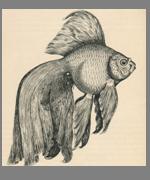
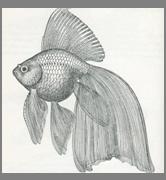
This fish pictured above was probably one of the best fringetails to reach the United States up to that time. This fringetail or its offspring were then most probably crossed to broadtail pearlscales, evidence being the pectorals on the Miejii fringetails pointed downward, pearlscale pectorals pointed outward from the body.
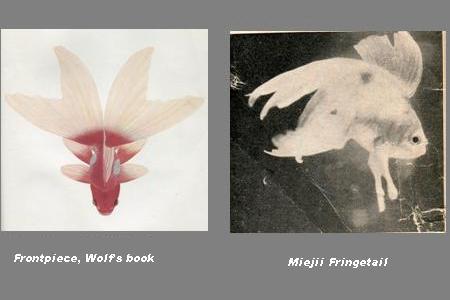
The relevance of the above is that in the resultant hybrids that we are using to produce square caudal fins today are still influenced by their forked caudal fringetail background. The current choptails of the Orient appear to have a different genetic background from our veils. Their short square tail is often produced in the majority of offspring and tends not to revert back to the forked caudal version when whole spawns are observed.
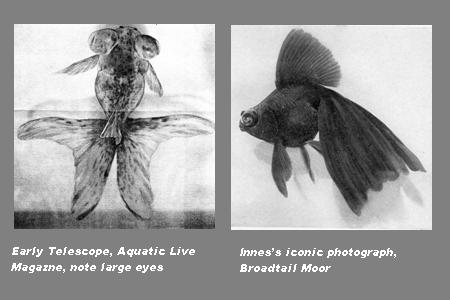
During the first decade of the 1900’s, the square caudal was successfully transferred to moors and calicoes, the calico form derived from crossing to calico telescopes imported by John Cugley During that time telescope versions of veils appear to have been more prized than non-telescope eye versions.

Veils were never produced by a large number of individuals; the centers of veiltail breeding were Philadelphia and New York. It appears that many fancy goldfish hobbyists were for the most part well off financially, very competitive in their shows, and did not readily share information to potential show competition. Complaints published in Aquatic Life during that period allude to this view. When tropical fish became available to the general public the goldfish hobby did not have a large healthy hobbyist base to compete. Goldfish quickly became secondary to tropical fish in popularity. A significant milestone was when veils were exported to England around 1920 where dedicated breeders have propagated them up to the present time. Additionally the Orient is currently producing veils in a number of varieties. However, they do differ from the traditional American/ English fish in having a more ryukin body structure, a very different fish. We prefer the American version with the graceful curve of the back. The only comment I would make here is breed for one or the other.
Goal: What should my ultimate fish look like?
One can’t cull before having a picture on paper or in the mind of that ultimate fish!
This is where Standards come into play. We use the UK Standards in conjunction with the old Philadelphia Standards for veils/broadtails. It is always popular to criticize Standards but Standards just don’t drop out of the sky. Valid Standards are put together over time by a number of hobbyists, not one, who have actually bred the variety. No Standard ever completely pleases a given hobbyist but the majority of persons critical of certain nuances have never bred the variety over one generation in the first place. It’s a fun and enjoyable challenge attempting to breed fish approaching a Standard goal.
At first glance the simple line drawings of the UK and old Philly Standards look almost silly in their simplicity. But with line drawings instead of actual pictures it is easier to see ratios. For example, the depth of the body should be at least ¾ the body length. During culling we then have the proper ratio of body depth to height in our minds. For me, this is more accurate than trying to “picture” that perfect fish. Using that line drawing I can more easily apply a ratio of body depth to length to the fish I am looking at in the culling process. The amount of detail in a “picture” Standard for us is distracting in forming a mental standard to use when culling.
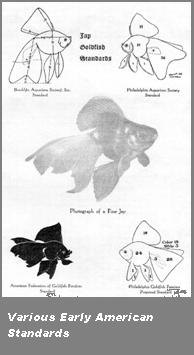
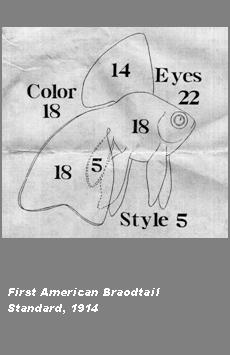
With veil/broadtail fins things are somewhat more complicated. When looking at your Standard you are looking at a mature veiltail at its prime, (for us, our preferences, overfinned). In culling, you will have to modify the Standard’s longer fins to what is appropriate to the age of the fish you are culling. Often a real challenge and any mistakes in selection may not be readily apparent. My own preference (DL) of the various Standards pictured above is the proposed Philadelphia Standard, left side of page, lower right. And you will need to decide at what age you want your veils to reach their prime, to look like the mature standard.
Next Page





